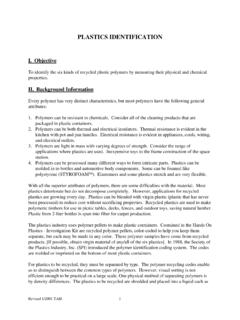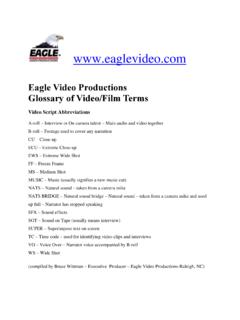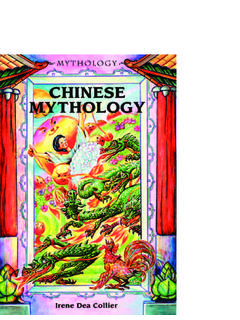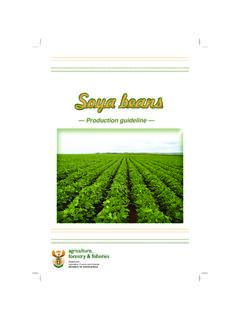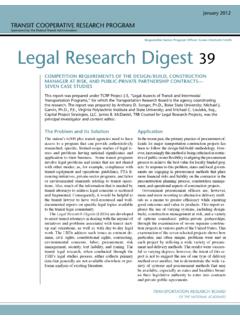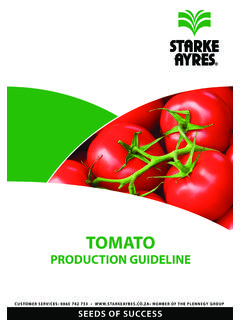Transcription of Agrodok 17 - Journey to Forever
1 Agrodok 17 Cultivation of tomato production, processing and marketingShankara Naika Joep van Lidt de Jeude Marja de Goffau Martin Hilmi Barbara van Dam Cultivation of tomato 2 This publication is sponsored by PROTA. Agromisa Foundation and CTA, Wageningen, 2005. All rights reserved. No part of this book may be reproduced in any form, by print, photocopy, microfilm or any other means, without written permission from the publisher. First edition: 1989 Second edition: 1993 Third edition: 2002 Fourth completely revised edition: 2005 Authors: Shankara Naika, Joep van Lidt de Jeude, Marja de Goffau, Martin Hilmi, Barbara van Dam Editor: Barbara van Dam Illustrator: Barbera Oranje Design: Eva Kok Translation: Sara van Otterloo-Butler Printed by: Digigrafi, Wageningen, Netherlands ISBN Agromisa: 90-8573-039-2 ISBN CTA.
2 92-9081-299-0 Introduction 3 ForewordTomato is one of the most widely cultivated crops in the world. It is an important source of vitamins and an important cash crop for small-holders and medium-scale commercial farmers. This Agrodok focuses on good practices for growing a healthy tomato crop and obtaining a reasonably steady yield. It provides practical in-formation on small-scale cultivation, harvesting, storing, processing and marketing of tomatoes.
3 Seed selection and conservation, inte-grated pest management methods and record keeping are also covered. We hope this information will be helpful to vegetable growers, whether beginners or more experienced farmers, extension workers and agricultural teachers. In this revised edition, the sections on pepper and paprika growing in previous editions have been omitted to make room for information on all the above-mentioned aspects of tomato cultivation. Agromisa entered a cooperation agreement with PROTA for the de-velopment of this publication.
4 For more information on PROTA see the section at the back of this Agrodok . We wish to express our thanks to Jan Siemonsma and Chris Bosch of PROTA, and to Remi Nono-Womdim, Gerard Grubben, Rene Geel-hoed, Bianca van Haperen and Guus van den Berg for their comments on the manuscript. We invite you as a reader to send your comments and suggestions on how to improve or extend the contents of this Agrodok . The authors Wageningen, September 2005 Cultivation of tomato 4 Contents1 Introduction 6 A brief description of tomato 6 2 Requirements for successful cultivation 10 Climate and soil 10 Choice of varieties 11 3 Preparation and planting 13 Land preparation 13 Seedlings 13 Transplanting 14 4 Crop husbandry 16 Manures and fertilisers 16 Watering
5 18 Pruning 20 Support systems 22 Weed control 24 Crop rotation 26 Protected cultivation 28 Organic farming 33 Sanitation practices 36 5 Pests and diseases 37 Nematodes 37 Insects 39 Diseases 44 Other causes of crop damage 54 Control of pests and diseases 55 6 Harvest and seed production 60 Harvest labour planning 61 When to harvest 62 Contents Seed selection and cultivation 63 Hybrid seed production 63 Seed quality 64 7 Post harvest handling 65 Handling 65 Storage
6 67 Processing 69 8 Marketing 78 What is a market? 78 Financing 80 About PROTA 87 Further reading 88 Useful addresses 90 Glossary 91 Cultivation of tomato 6 1 A brief description of tomato Tomato (Lycopersicon esculentum Mill.)
7 Is one of the most important vegetables worldwide. World tomato production in 2001 was about 105 million tons of fresh fruit from an estimated million ha. As it is a relatively short duration crop and gives a high yield, it is eco-nomically attractive and the area under cultivation is increasing daily. Tomato belongs to the Solanaceae family. This family also includes other well-known species, such as potato, tobacco, peppers and egg-plant (aubergine). Tomato has its origin in the South American Andes.
8 The cultivated tomato was brought to Europe by the Spanish conquistadors in the sixteenth century and later introduced from Europe to southern and eastern Asia, Africa and the Middle East. More recently, wild tomato has been distributed into other parts of South America and Mexico. Common names for the tomato are: tomate (Spain, France), tomat (In-donesia), faan ke e (China), tomati (West Africa), tomatl (Nahuatl), jitomate (Mexico), pomodoro (Italy), nyanya (Swahili). Tomatoes contribute to a healthy, well-balanced diet.
9 They are rich in minerals, vitamins, essential amino acids, sugars and dietary fibres. Tomato contains much vitamin B and C, iron and phosphorus. Tomato fruits are consumed fresh in salads or cooked in sauces, soup and meat or fish dishes. They can be processed into pur es, juices and ketchup. Canned and dried tomatoes are economically important processed products. Yellow tomatoes have higher vitamin A content than red tomatoes, but red to-matoes contain lycopene, an anti-oxidant that may contribute to protection against carcinogenic substances.
10 Introduction 7 Tomato (see Figure 1) is an annual plant, which can reach a height of over two metres. In South America, however, the same plants can be harvested for several years in succession. The first harvest is possible 45-55 days after flowering, or 90-120 days after sowing. The shape of the fruit differs per cultivar. The colour ranges from yellow to red. Figure 1: Tomato Cultivation of tomato 8 Three different types of tomato plants can be distinguished: ?
